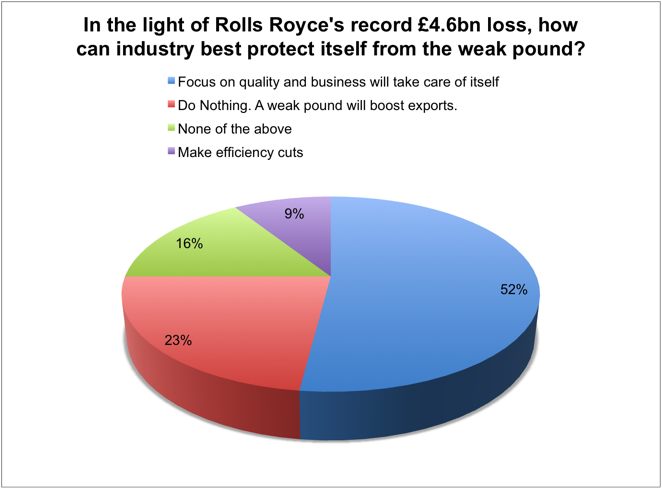Last week's poll: Rolls-Royce and the weak pound
Post-Brexit reports indicate that manufacturers in Britain are benefitting from the drop in sterling but that hasn’t been the case for Rolls Royce, which recently posted a £4.6bn loss.

The engineering giant announced its biggest pre-tax loss on February 14, 2017 with the decline of sterling accounting for a £4.4bn hit on the value of the investments that it uses to protect itself from currency fluctuations.
With most international aerospace contracts priced in dollars, these hedges were primarily designed to protect the company from falls in the value of US currency. However, since the 2016 Brexit vote, the pound has fallen by around 19 per cent against the dollar.
Analysts are predicting further drops in the value of sterling once the formal process of leaving the EU begins, prompting The Engineer to ask what industry should do to adapt to the new reality of a weaker pound.

Just over half (52 per cent) of respondents agreed that a focus on quality will ensure continued success in business, whilst just under a quarter (23 per cent) thought that industry should do nothing because the weak pound is a fillip for exports.
Register now to continue reading
Thanks for visiting The Engineer. You’ve now reached your monthly limit of news stories. Register for free to unlock unlimited access to all of our news coverage, as well as premium content including opinion, in-depth features and special reports.
Benefits of registering
-
In-depth insights and coverage of key emerging trends
-
Unrestricted access to special reports throughout the year
-
Daily technology news delivered straight to your inbox










Breaking the 15MW Barrier with Next-Gen Wind Turbines
Hi Martin, I don´t have any detailed parameters for the 15MW design other than my reading of the comment in the report ´aerodynamic loads at blade-tip...